Are Yellow Garden Spiders Poisonous to Dogs?
Are Yellow Garden Spiders poisonous to dogs? In this article, we’ll explain everything you need to know if your dog had an encounter with a Yellow Garden Spider, including the commands you’ll need to ensure you won’t have any spider problems with your dog in the future.
After explaining what to do if a Yellow Garden Spider bites your dog or if your dog ate one, we’ll cover everything you need to know about Yellow Garden Spiders. That includes where they live, what they look like, and how big they are. We’ll then finish by telling you if Yellow Garden Spiders are beneficial and how to keep your dog away from them. Keep reading!
Are Yellow Garden Spiders Poisonous to Dogs?
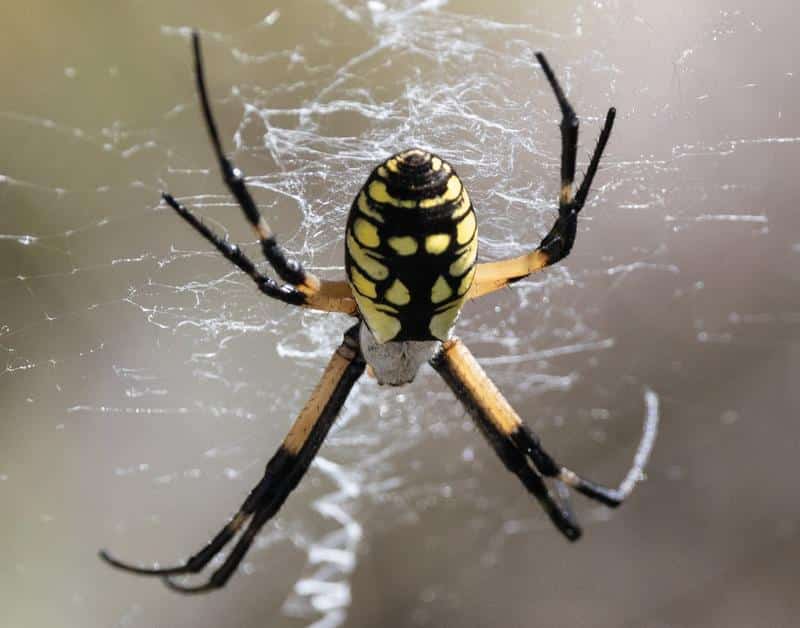
Yellow Garden Spiders are not poisonous to dogs. Their venom is not strong enough to pose a significant threat to canines. However, like any spider bite, it can cause mild discomfort and irritation. In the event that you have a dog bitten by a Yellow Garden Spider, it’s always wise to monitor them for any unusual behavior or signs of an allergic reaction.
Are Yellow Garden Spiders Dangerous to Dogs?
Yellow Garden Spiders (Argiope aurantia) are not inherently dangerous to dogs, but their bites can cause temporary discomfort. These spiders, like most, are more likely to flee than bite, and their venom is mainly used to subdue their prey rather than as a defensive mechanism.
However, if a dog provokes a Yellow Garden Spider, it may bite in self-defense, resulting in temporary pain, redness, and swelling at the bite site.
Yellow Garden Spider Bites Dog
If a Yellow Garden Spider bites your dog, first, try not to panic. The bite is not life-threatening. You may notice some redness, swelling, or even a small puncture wound. Your dog may also seem bothered or uncomfortable.
To soothe the bite site, you can apply a cold compress. If your dog appears overly distressed, it’s best to contact your vet for further advice.
How to Train the “Stay” Command
Training your dog to stay can help prevent them from disturbing spiders or other potentially harmful creatures. Here’s a simple way to start:
- Ask your dog to sit or lie down.
- With a treat in your hand, extend your arm out in front of you, palm facing outwards, and say “Stay.”
- If your dog remains in place, reward them with the treat and praise. If not, don’t reward them and repeat the process.
- Gradually increase the amount of time you ask your dog to stay before rewarding them.
Remember, patience is key when training dogs.
How to Train the “Leave It” Command
The “Leave It” command can also be valuable in situations where your dog might disturb a spider. Here are some steps to teach it:
- Hold a treat in your closed hand and present it to your dog, saying “Leave it.”
- Your dog will probably try to get the treat by licking, sniffing, or pawing at your hand. Ignore these behaviors.
- As soon as your dog stops trying to get the treat and pulls away, praise them and give them a different treat from your other hand.
- Repeat this process until your dog reliably moves away from the first treat when you give the command.
These commands will get your dog to stay away from Yellow Garden Spiders, but it’s important to remember that the underlying behavioral issues (prey drive, curiosity, overexcitement, etc.) that were causing all of this to begin with will still be present. And until you address those, any positive changes you see are only going to be temporary.
“Well, how do I make these changes last?”
By getting your dog to truly choose to follow your direction, that’s how. I tried many times to write out how you can do that before deciding it made more sense to just link you to the free video series that explains it better than I’d ever be able to.
The series is by a man named Dan who is one of the world’s leading dog obedience trainers. In it, he teaches you how to put an end to things like when your dog eating Yellow Garden Spiders and all other misbehavior using his fast and easy-to-follow methods.
In the first video, Dan will reveal to you why the two most common methods of dog training only doom you to failure. You can watch the video now by clicking here. Follow the proven system he’ll show you in his series and you’ll never have to spend another second worrying about your dog bothering Yellow Garden Spiders ever again!
My Dog Ate a Yellow Garden Spider
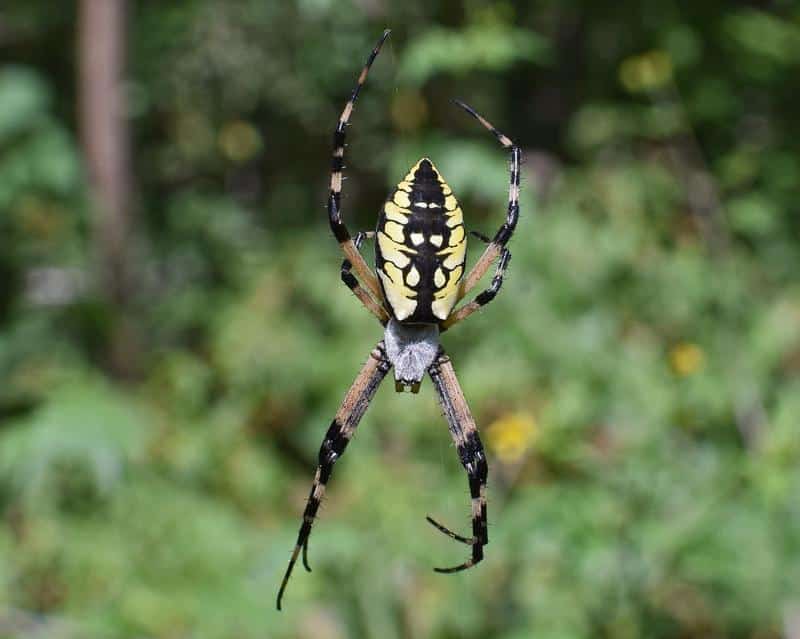
If your dog ate a Yellow Garden Spider, don’t panic. These spiders are not toxic to dogs, but might cause mild discomfort. Monitor your pet for signs of distress such as drooling, vomiting, or loss of appetite, and contact your vet if symptoms persist.
Dogs are often curious creatures, sniffing and tasting various things in their environment, including spiders. While many spiders pose no harm to dogs, it can be alarming when your pet ingests one, particularly a spider as noticeable as the Yellow Garden Spider. Here’s what you should know:
- Yellow Garden Spider Toxicity: The Yellow Garden Spider, also known as the black and yellow garden spider or the writing spider, is not poisonous to dogs. Their venom is not potent enough to cause serious harm to your pet. However, every dog may react differently, and some dogs might experience mild discomfort.
- Possible Symptoms: Some dogs might show signs of discomfort like excessive drooling, loss of appetite, or vomiting. These symptoms usually resolve within a few hours as the spider is naturally expelled from the dog’s system.
- Monitor Your Pet: Keep an eye on your dog after it has ingested the spider. Watch for signs of distress and take note of any changes in behavior. If symptoms persist or your dog appears to be in pain, it’s crucial to seek veterinary attention immediately.
- Preventative Measures: To avoid such incidents in the future, try to keep your garden clean and free from spiders and other insects that may pique your dog’s curiosity. Regularly inspect your yard for spiders, and remove them if found. Learn the commands that will help in the first section.
Although it’s concerning when your dog eats a Yellow Garden Spider, there’s generally no need for alarm. The spider isn’t toxic to dogs, but monitoring your pet’s behavior and contacting your vet if symptoms persist is advisable. Prevention is also key; maintaining a clean garden can significantly reduce such occurrences in the future.
You need to make sure you take care of this problem now so that your dog will be safe during future interactions. This means you won’t have to think about things like what to do if a grass spider bites your dog, if orb weaver spiders are poisonous to dogs, if you have a dog bit by a wolf spider, or if jumping spiders are poisonous to dogs.
Yellow Garden Spider: What to Know
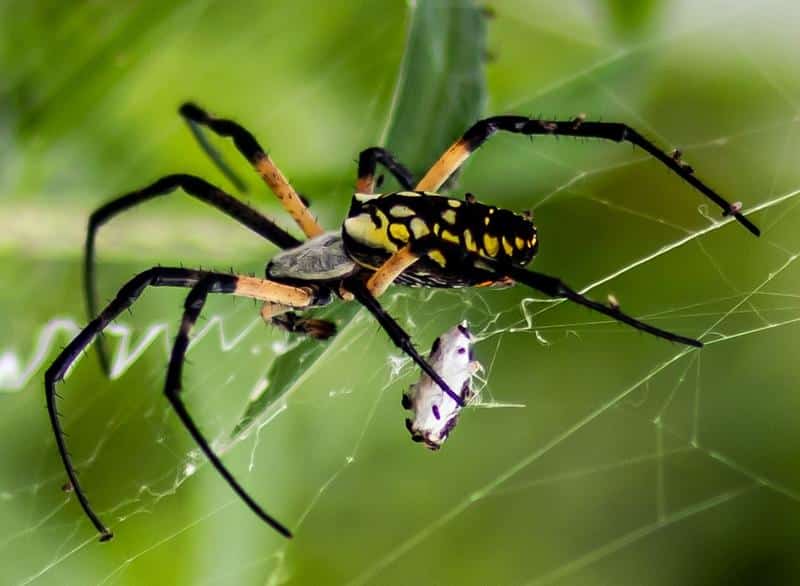
The Yellow Garden Spider (Argiope aurantia) is a striking, non-aggressive arachnid native to North America. Known for their unique appearance and large, intricate webs, these spiders are often found in gardens and other vegetated areas, hence the name. Although their size and color might be intimidating, they are not dangerous to humans or dogs.
Where Do Yellow Garden Spiders Live?
Yellow Garden Spiders are native to the continental United States, Mexico, and Central America. They thrive in moderate climates and are often seen during the summer and fall. In the United States, you can find them from coast to coast, although they’re particularly common in the South and Midwest.
Where Are Yellow Garden Spiders Found?
Yellow Garden Spiders are named for their preferred habitat: gardens. They are often found among flowers, shrubs, and tall plants, where they can build their large, intricate webs. These spiders also tend to inhabit farms, forests, and suburban yards. They’re beneficial to gardeners, as they eat a variety of pest insects.
What Do Yellow Garden Spiders Look Like?
Yellow Garden Spiders are quite distinct. Females are the most noticeable, with a silver to white cephalothorax (head), and a large, round abdomen that’s usually black with yellow or orange markings.
They also have black legs with yellow bands. Males are much smaller and less colorful, with brown bodies and less noticeable banding on their legs.
How Big Are Yellow Garden Spiders?
There’s a significant size difference between male and female Yellow Garden Spiders. Females are larger, measuring up to 1 inch (25 mm) in body length, not including the legs. Males, on the other hand, are quite small, typically reaching only about a quarter of the size of females.
In conclusion, Yellow Garden Spiders are harmless arachnids commonly found in various regions across the United States. They’re distinct in appearance, particularly the large, vibrant females. These spiders are beneficial to their ecosystems, controlling pest populations in gardens and farms.
While they might seem intimidating, there’s no need for concern if you or your dog come across one. Learn the “stay” command so that your dog will keep their distance by going back to the first section now.
Are Yellow Garden Spiders Beneficial?
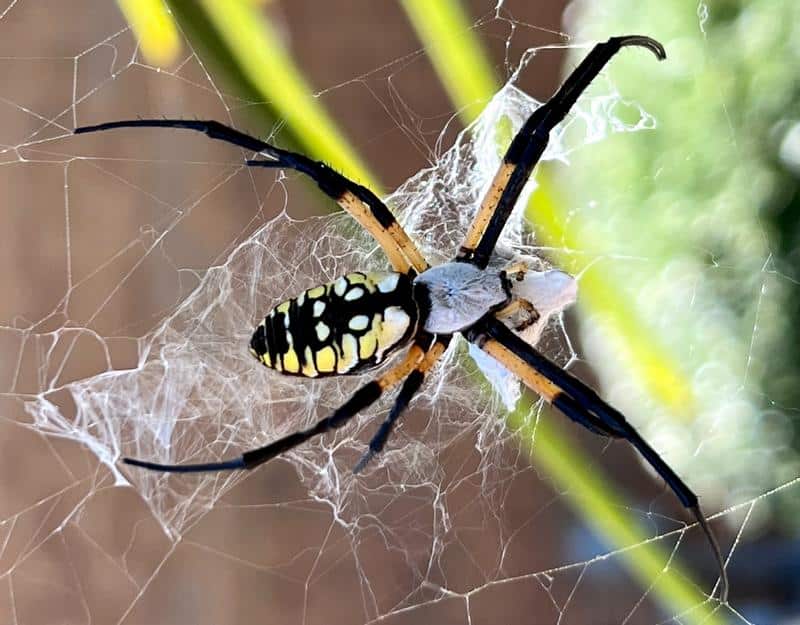
Yellow Garden Spiders are beneficial. They play an essential role in controlling pests in your garden as they feed on a variety of insects. Despite their intimidating appearance, these spiders are harmless to humans and are a natural and effective pest control solution.
The Yellow Garden Spider, also known as Argiope aurantia, is a common sight in many gardens across North America. Their bright color and large web may be intimidating, but they offer numerous benefits to our gardens. Here’s how:
- Pest Control: Yellow Garden Spiders eat a variety of insects, including flies, mosquitoes, and small beetles. By catching and consuming these pests, they help maintain a balance in your garden’s ecosystem and prevent the overpopulation of certain insect species.
- Non-Aggressive: Although they may look scary, Yellow Garden Spiders are non-aggressive towards humans. They generally only bite in self-defense, and their venom isn’t harmful to humans. They prefer to stay in their webs, so the likelihood of accidental contact is low.
- Pollination: By capturing and eating various insects, these spiders indirectly aid in pollination. Insects that escape the spider’s web will have pollen attached to them, which gets transferred to other plants.
- Biodiversity: Spiders are a vital part of the food chain and contribute to biodiversity. They serve as food for birds and other larger creatures, contributing to the balance of your garden’s ecosystem.
In conclusion, Yellow Garden Spiders are highly beneficial for your garden. They serve as a natural pest control, contribute to biodiversity, and indirectly assist in pollination. Despite their somewhat fearsome appearance, they are harmless and beneficial companions for your garden.
That’s why you’ll want to be sure that your dog knows to stay away from these helpful garden pals. Learn how to do that in the first section.
How to Keep Dogs Away from Yellow Garden Spiders
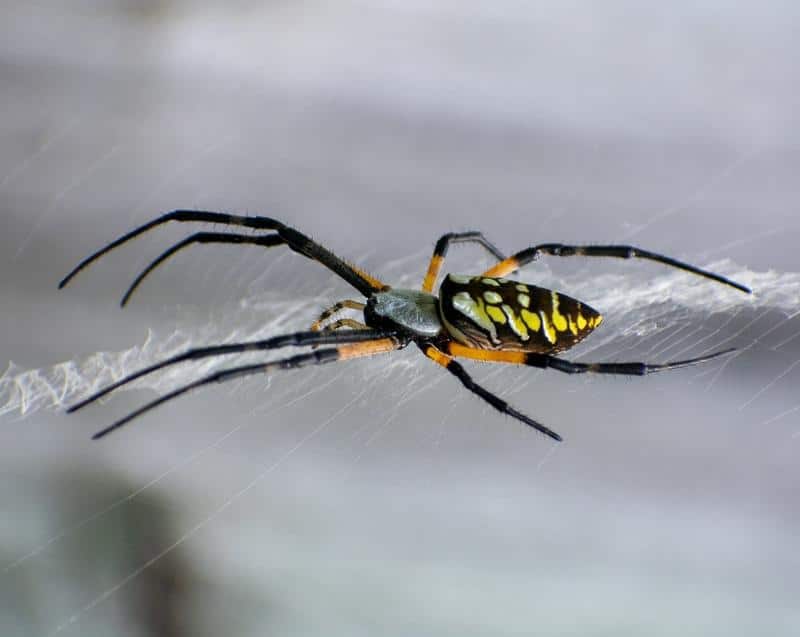
To keep dogs away from Yellow Garden Spiders, ensure a safe play space, train your dog to avoid them, use natural spider repellents, and regularly check for spiders in the yard. Understanding that spiders are generally harmless but can provoke defensive reactions if disturbed is key to maintaining a spider-safe environment for your pet.
Yellow Garden Spiders can be a curious sight for our canine friends. Although these spiders are not harmful, it’s wise to prevent any potential encounters that could lead to a spider being frightened and biting in self-defense.
Here are steps you can take to keep your dog away from Yellow Garden Spiders:
- Create a Safe Play Space: Designate an area in your yard where your dog can play, that’s away from areas where spiders typically reside. This might be an open grassy area or a dedicated dog run. Regularly check this area for any spider webs or spiders.
- Training: Train your dog to avoid spiders and their webs. You can do this through voice commands like “leave it” or “stay.” Reward your dog when it obeys these commands, to reinforce the behavior. Learn how to do these in the first section.
- Use Natural Spider Repellents: Certain natural substances, like essential oils (e.g., peppermint and citrus), can help deter spiders. Sprinkle these in areas where your dog plays. However, be sure to research or consult with a vet to confirm that your chosen repellent is safe for dogs.
- Regular Yard Maintenance: Regularly maintaining your yard can reduce the number of places where spiders can build their webs. Trim back plants and remove any debris or clutter where spiders may hide.
While Yellow Garden Spiders are beneficial and generally not a threat, it’s important to keep your dogs from disturbing them. By creating a safe play space, training your dog (go back to the first section for help), using natural repellents, and maintaining your yard, you can keep your pet safe and preserve these useful garden helpers.
I’m sure you’re looking forward to not worrying about this problem anymore, so I’ll let you get started. Good luck with all of this, and thanks for reading our article “Are Yellow Garden Spiders Poisonous to Dogs?”





